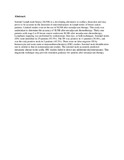| dc.contributor.author | Isaacs, Gilbert | |
| dc.contributor.author | Jasnosz, Katherine | |
| dc.contributor.author | Nathan, Girija | |
| dc.contributor.author | Olson, Peter | |
| dc.contributor.author | Dusi, Deborah | |
| dc.contributor.author | Patel, Nilesh | |
| dc.contributor.author | Julian, Thomas B | |
| dc.date.accessioned | 2013-06-29T11:48:36Z | |
| dc.date.available | 2013-06-29T11:48:36Z | |
| dc.date.issued | 2001-10 | |
| dc.identifier.citation | The American Journal of Surgery Volume 182, Issue 4 , Pages 407-410, October 2001 | en |
| dc.identifier.uri | http://erepository.uonbi.ac.ke:8080/xmlui/handle/123456789/42442 | |
| dc.description.abstract | Sentinel lymph node biopsy (SLNB) is a developing alternative to axillary dissection and may prove to be accurate in the detection of micrometastases in lymph nodes of breast cancer patients. Limited studies exist in the use of SLNB after neoadjuvant therapy. This study was undertaken to determine the accuracy of SLNB after neoadjuvant chemotherapy.
Thirty-one patients with stage I or II breast cancer underwent SLNB after neoadjuvant chemotherapy.
Lymphatic mapping was performed by radioisotope, blue dye, or both techniques. Sentinel nodes (SN) were identified in 29 patients (93.5%). The SN was positive in 11 patients (38.0%), and was the only positive node in 5 patients (45.5%). There were no false negative SN by hematoxyin and eosin stain or immunohistochemistry (IHC) studies.
Sentinel node identification rate is similar to that in nonneoadjuvant studies. The sentinel node accurately predicted metastatic disease in the axilla. IHC studies failed to detect any additional micrometastases. This diagnostic technique may provide treatment guidance for patients after neoadjuvant therapy. | en |
| dc.language.iso | en | en |
| dc.title | Sentinel lymph node biopsy after neoadjuvant chemotherapy for breast cancer | en |
| dc.type | Article | en |
| local.publisher | Department of Surgery | en |

